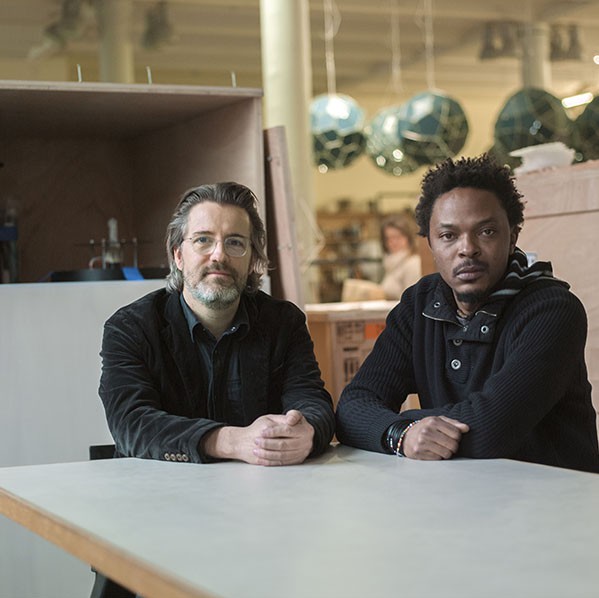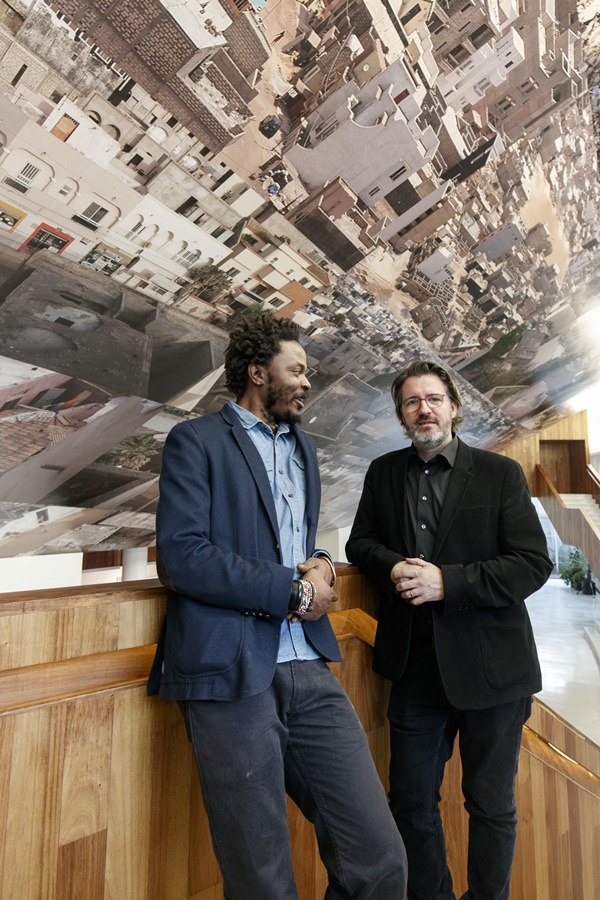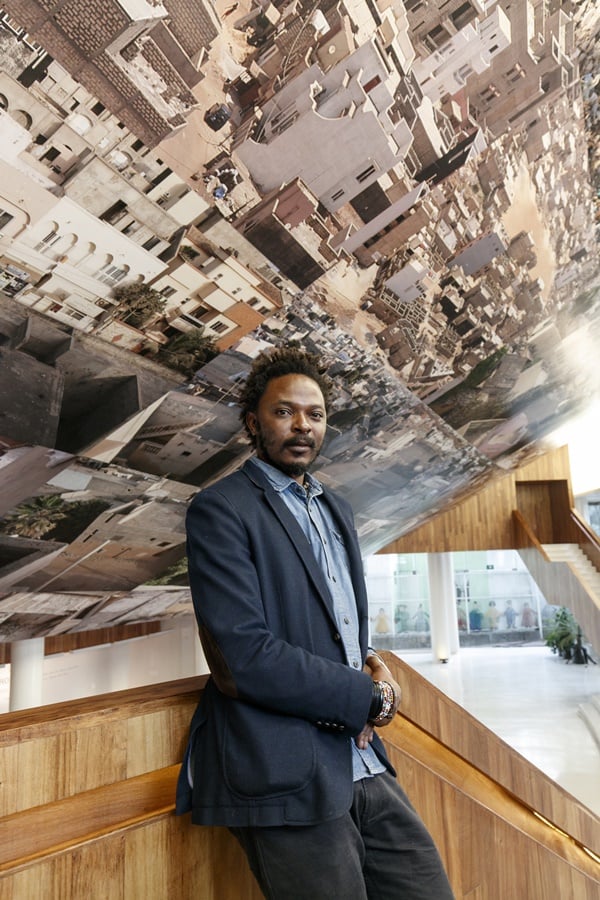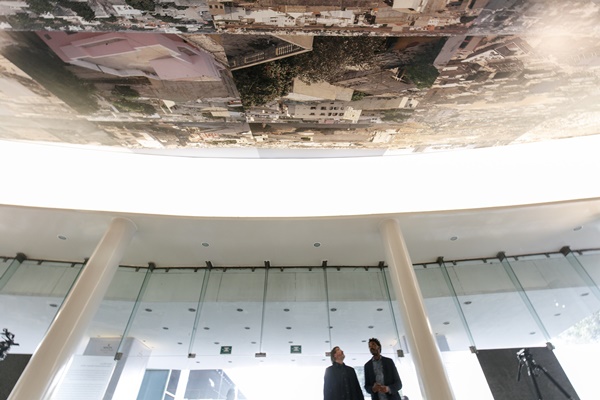Art World
With Olafur Eliasson as Mentor, Sammy Baloji’s Work Takes New Direction
The two teamed up for the Rolex Arts Initiative.

The two teamed up for the Rolex Arts Initiative.

Laura van Straaten


Rolex Arts Weekend at Centro Cultural del Bosque – Mexico, December 5, 2015. Congolese artist and photographer Sammy Baloji created an installation in the lobby of Teatro Julio Castillo. The event was accompanied by a conversation with his mentor Olafur Eliasson.
It was announced on Sunday that Joan Jonas, the internationally acclaimed performance and video artist, will be the visual arts mentor for the Rolex Mentor and Protégé Arts Initiative, which pairs leaders in six artistic fields with emerging talents for a year for support, guidance and collaboration.
The announcement took place at the Centro Cultural del Bosque in Mexico City, on whose campus Rolex hosted its biannual Arts Weekend with performances and presentations of work by this past year’s mentors and protégés for an audience comprised of several hundred people: former mentors and protégés, nominators and advisers from all over the world; international journalists; local artists and ticketed members of the general public.
But before the Jonas announcement was made, the outgoing mentor in visual arts, Olafur Eliasson, celebrated his protégé of the last year, the photographer and filmmaker Sammy Baloji, in a co-presentation of a site specific new work by Baloji on Saturday and in a moving tribute before a packed audience on Sunday.
Through his work, Baloji, who divides his time between Belgium and his native Democratic Republic of the Congo, explores ethnography, architecture, and urbanism.

Rolex Arts Weekend at Centro Cultural del Bosque – Mexico, December 5, 2015. Congolese artist and photographer Sammy Baloji created an installation in the lobby of Teatro Julio Castillo. The event was accompanied by a conversation with his mentor Olafur Eliasson.
The work Baloji presented to the weekend’s participants was a busy photo-grid on the complicatedly curved and angled ceiling of the lobby of Mexico’s celebrated Teatro Julio Castillo, part of the Centro Cultural del Bosque (CCB), the largest performing arts complex in Mexico. The images are of the rubble-strewn streets and concrete roofs of Dakar, Senegal that Baloji assembled to form a disjointed landscape of the city.
“Tradition is starting to disappear with this new building of buildings in the Western way,” said Baloji, who explained that his work is rooted in socio-political observations and inquiries. Yet in the course of many discussions and studio visits with Eliasson, Baloji decided to experiment in a new medium.
The mentorship involved a number of short but intense meetings, predominantly in Berlin, the site of Eliasson’s studio. The artists focused on the “hows and whys” (as Eliasson put it) of Baloji’s research-heavy, archive-driven practice, which has been especially concerned with issues of colonialism and its lasting legacy.
Mentors in the Rolex Arts Initiative are asked to spend up to six weeks in person with their protégés, but the pairs may meet and interact when and where they wish.
Eliasson helped Baloji explore how this practice could evolve from its foundation in photography into new media. Baloji’s first sculptural installation, “The Other Memorial” (2015), created for the 56th Venice Biennale and shown in the main exhibition in the Arsenale, became the duo’s focal point. A dome fashioned from 50 copper panels each with an image of a scarified body (an etching of a pattern onto a human body that was a cultural signifier in Congolese tribes in the 20th century), the work comments on the continuing plunder of both human and mineral resources (especially copper) in Congo.

Rolex Arts Weekend at Centro Cultural del Bosque – Mexico, December 5, 2015. Congolese artist and photographer Sammy Baloji created an installation in the lobby of Teatro Julio Castillo. The event was accompanied by a conversation with his mentor Olafur Eliasson.
“He [Eliasson] didn’t tell me which direction I should go in,” Baloji, whose first language is French, is quoted as saying in press materials provided by Rolex. “Instead, he showed me how he worked, and encouraged me to find my own way through. He said there was no rule: you have to experiment. He’s not concentrated in just one field. He can make artworks with photography or video; he can make installations; he can make art with water; sometimes he makes paintings. I am trying to understand how he chooses one medium over another, and how he knows that the object reflects his thinking.”
While mentor and protégé have not collaborated outright, Eliasson said in an interview that he is seriously thinking about what the two might do together for 2017 iteration of the Lubumbashi Biennale, which Baloji co-founded and which led to the formation of the Picha Art Centre whose mission is to support emerging Congolese artists. “We have discussed collaborating on something there,” Eliasson said and Baloji nodded in agreement. “We are in a collaborative mode already.”
In March, Baloji will have a solo exhibition at the Contemporary Art Center Brussels.
The more reserved and almost brooding Baloji,36, towered in height over his effusive, cerebral and bespectacled mentor, 48, who throughout the weekend vocalized a desire for more companies to support culture in the way Rolex has: “Rolex gets that the foundation of culture is relationships,” he said, “not the creation of objects.”

Rolex Arts Weekend at Centro Cultural del Bosque – Mexico, December 5, 2015. Congolese artist and photographer Sammy Baloji created an installation in the lobby of Teatro Julio Castillo. The event was accompanied by a conversation with his mentor Olafur Eliasson.
Eliasson said he vowed in agreeing to be a mentor that he did not want to take a “paternalistic” or “patriarchic” role. “Sammy and I are colleagues and we are working in the same field and I just happen to have been doing it for 20 years,” he said. “I went into this confident that I would be able to learn as much from Sammy as he from me.”
Jonas, who was not present, will be a mentor along with six other master artists including architect David Chipperfield, who is responsible for Berlin’s Neues Museum, the UK’s landmarked Turner Contemporary gallery Mexico’s Museo Júmex (which the weekend’s participants toured on Friday night) and is at work new wing for the Metropolitan Museum of Art. The others are director Alfonso Cuarón (film); Philip Glass (music); Mia Couto (literature); Robert Lepage (theatre) and Ohad Naharin (dance).
Often described as a “titan of the American avant garde” for her pioneering use of video in the 1970s and for her use the TV monitor as a sculptural object, Jonas, now 80, represented the United States at the 2015 Venice Biennale with a multimedia installation that drew huge crowds and, largely, acclaim. She is based in New York City and is the only woman among the new class of mentors.
Past mentors in the visual arts include Sir Anish Kapoor; Rebecca Horn; John Baldessari; David Hockney; and William Kentridge, who during a group tour of Mexico City landmarks and murals on Sunday morning was often seen tipping back his trademark black hat to peer at and snap iPhone photos.